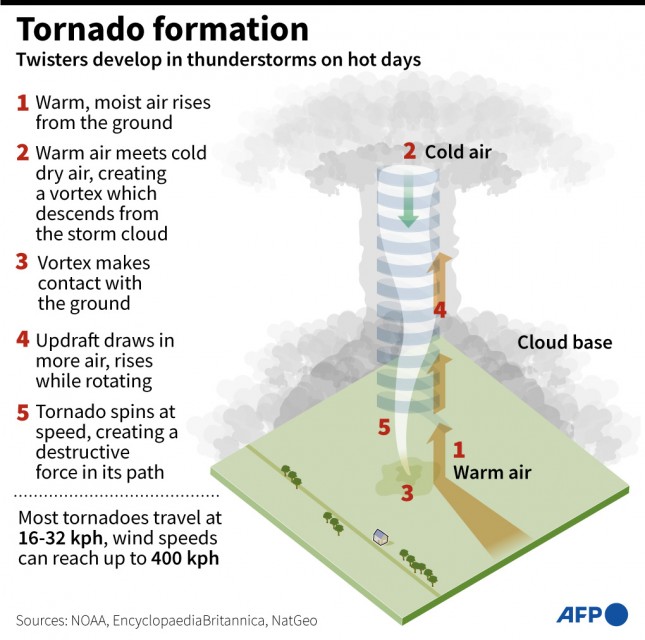
by Lucie AUBOURG
WASHINGTON, United States (AFP) — Was climate change behind the recent tornadoes that killed dozens of people and wrought a trail of destruction through five American states?
Higher temperatures might create more favorable conditions for these violent storms, but for now, scientists remain cautious about drawing a direct connection.
While research has firmly linked recent extreme weather events to global warming — from this summer’s heatwaves in North America to flooding in western Europe — there remain important gaps in the scientific understanding of twisters and how they relate to climate.
“At least in the past few decades, we have seen a trend towards more favorable conditions,” especially in winter in the country’s midwest and southeast, John Allen, a climatologist at Central Michigan University, told AFP.
But “it is misleading to attribute this event to climate change,” he added.
James Elsner, professor of climatology at Florida State University, draws a comparison with what we know about the connection between fog and car crashes: foggy conditions on the road are associated with a higher number of accidents, but individual crashes in heavy fog aren’t always due to poor visibility.
In the same vein, knowing what the link is between climate change and tornadoes with more certainty requires further investigation.
This is where the field of “attribution science,” which has made enormous strides in recent years, comes in.
The idea is to feed climate data into computer models to analyze the probability specific extreme weather events would have occurred in a world without human-driven climate change, versus the world we live in today.
But such studies take time to carry out and are particularly tricky for tornadoes, which are more difficult to model than other extreme weather phenomena because of a relative lack of data.
It’s even too early to say for sure that climate change will increase the frequency of winter twisters.
“I think you could probably argue that seems to be the way the evidence is pointing. But I don’t think we’re at the point now where we can definitively say ‘yes, this is climate change,'” said Allen.
The latest United Nations Intergovernmental Panel for Climate Change (IPCC) report underlined there was “low confidence” on a link between global warming and small-scale phenomena such as tornadoes, both in observed trends and in projections.
Shifting patterns
The average number of tornadoes per year in the United States has not increased in recent years, hovering around 1,300, with most occurring in spring.
“Most months have shown a decline in the number of tornadoes and the number of days hosting tornadoes over the last, say 30 years or even 40 years,” said Jeff Trapp, an atmospheric scientist at the University of Illinois.
The exception, he says, are the months of December and January, which have seen increases in tornado activity over the same period — a result that is at least “consistent” with a “potential climate explanation.”
Tornadoes form from thunderstorms, when warm, moist air encounters colder falling air with rain or hail. This creates spinning air currents that start out horizontal and may become vertical.
In recent years, “What we do tend to see is a higher likelihood of having warm days during the cool season, that could support thunderstorms and tornadoes,” said Trapp.
What’s more, when tornadoes do form, the outbreaks have become more clustered, even though the sum total across the year is about the same, said Chiara Lepore, a researcher at Columbia University.
Finally, scientists note an eastward shift in the so-called “Tornado Alley,” with more storms likely to hit Arkansas, Mississippi, or Tennessee — all three of which were affected this weekend.
What to expect next?
The problem researchers have in studying tornadoes is that they are fleeting and small in size and they are hard to “see” on climate models, unlike bigger events like hurricanes or heat waves.
Scientists, therefore, can only study changes in the conditions potentially favorable to them forming.
A recent study found that for every degree Celsius of warming, there is an increase of between 14 to 25 percent in severe thunderstorm likelihood over the United States.
But it’s still difficult to infer how this would translate to more tornadoes, said Lepore, the study’s lead author.
According to another forthcoming modeling paper co-authored by Trapp, “tornadoes may become more powerful in future climate,” he said.
However, very violent tornadoes will remain “rare events,” rather than a “new normal,” he predicted.
“We’re in the early stages of trying to understand the link between climate change and what we call severe local storms,” including tornadoes and hail storms, said Elsner.
“But in the next five or 10 years, I think you’re going to see some real advances.”
© Agence France-Presse








